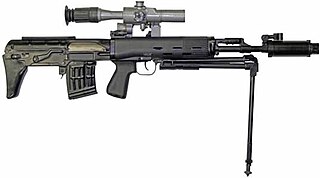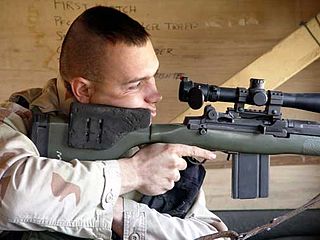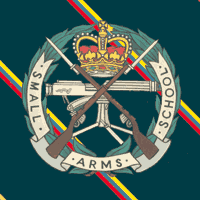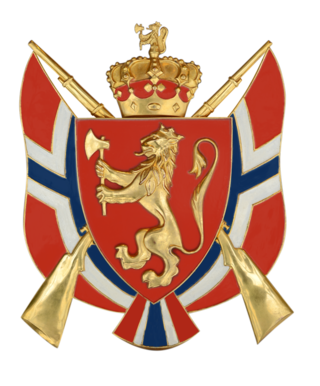Related Research Articles

The SA80 is a British family of 5.56×45mm NATO service weapons used by the British Army. The L85 Rifle variant has been the standard issue service rifle of the British Armed Forces since 1987, replacing the L1A1 Self-Loading Rifle. The first prototypes were created in 1976, with production of the A1 variant starting in 1985 and ending in 1994. The A2 variant came to be as the result of a significant upgrade in the early 2000s by Heckler & Koch and remains in service as of 2020. The A3 variant was first issued in 2018 with several new improvements.

A bullpup firearm is one with its firing grip located in front of the breech of the weapon, instead of behind it. This creates a weapon with a shorter overall length for a given barrel length, and one that is often lighter, more compact, concealable and more maneuverable than a conventionally configured firearm. Where it is desirable for troops to be issued a more compact weapon, the use of a bullpup configuration allows for barrel length to be retained, thus preserving muzzle velocity, range and ballistic effectiveness.

The Lee–Enfield or Enfield is a bolt-action, magazine-fed repeating rifle that served as the main firearm of the military forces of the British Empire and Commonwealth during the first half of the 20th century, and was the British Army's standard rifle from its official adoption in 1895 until 1957. The WWI versions are often referred to as the "SMLE", which is short for the common "Short, Magazine, Lee–Enfield" variant.

The Canadian Army is the command responsible for the operational readiness of the conventional ground forces of the Canadian Armed Forces. It maintains regular forces units at bases across Canada, and is also responsible for the Army Reserve, the largest component of the Primary Reserve. The Army is headed by the concurrently held Commander of the Canadian Army and Chief of the Army Staff, who is subordinate to the Chief of the Defence Staff. The Army is also supported by 3,000 civilian employees from the civil service.

The Irish Army, known simply as the Army, is the land component of the Defence Forces of Ireland. Approximately 7,300 people served in the Irish Army on a permanent basis as of May 2016, and there were 1,600 active reservists, divided into two geographically organised brigades. By late September 2020, this had reduced to 6,878 permanent army personnel.

The Carl Gustaf 8.4 cm recoilless rifle is a Swedish developed 84 mm (3.3 in) caliber man-portable shoulder-fired recoilless rifle, initially developed by the Royal Swedish Army Materiel Administration during the second half of the 1940s as a close-range anti-tank and support weapon for infantry, which has seen great export success around the globe and is today a popular multi-purpose support weapon in use by many nations. The Carl Gustaf 84 mm recoilless rifle is a lightweight, low-cost weapon that uses a wide range of ammunition, which makes it extremely flexible and suitable for a wide variety of roles.

A designated marksman (DM), squad advanced marksman (AD) or squad designated marksman (SDM) is a military marksman role in an infantry squad. The term sniper was used in Soviet doctrine although the soldiers using the Dragunov SVD were the first to use a specifically designed designated marksman rifle. The analogous role in the Israel Defense Forces is sharpshooter.

A section is a military sub-subunit. It usually consists of between 6 and 20 personnel. NATO and U.S. doctrine define a section as an organization "larger than a squad, but smaller than a platoon." As such, two or more sections usually make up an army platoon or an air force flight.

A marksman is a person who is skilled in precision shooting using projectile weapons to shoot at high-value targets at longer-than-usual ranges.

In the United States (U.S.), a marksmanship badge is a U.S. military badge or a civilian badge which is awarded to personnel upon successful completion of a weapons qualification course or high achievement in an official marksmanship competition. The U.S. Army and the U.S. Marine Corps are the only military services that award marksmanship qualification badges. However, marksmanship medals and/or marksmanship ribbons are awarded by the U.S. Navy, U.S. Coast Guard, and U.S. Air Force for weapons qualifications. For non-military personnel, different U.S. law enforcement organizations and the National Rifle Association (NRA) award marksmanship qualification badges to those involved in law enforcement. Additionally, the Civilian Marksmanship Program (CMP) and the NRA award marksmanship qualification badges to U.S. civilians. Most of these organizations and the U.S. National Guard award marksmanship competition badges to the people they support who succeed in official competitions.

The National Rifle Association (NRA) is the governing body for full bore rifle and pistol shooting sports in the United Kingdom. Registered as a United Kingdom charity, its objectives are to "promote and encourage marksmanship throughout the King’s dominions in the interest of defence and the permanence of the volunteer and auxiliary forces, naval, military and air." The formal purposes of the charity are to promote the efficiency of the armed forces of the Crown, or the police, fire and rescue or ambulance services. The National Shooting Centre at Bisley is a wholly-owned subsidiary of the association.

The Small Arms School Corps (SASC) is a small corps of the British Army, established in 1853 by Lord Hardinge. Its personnel provide advice and instruction to infantry weapon trainers throughout the army, in order to maintain proficiency in the use of small arms and support weapons, and in range management.

The Ukrainian Ground Forces, also known as the Ukrainian army, are the land forces of Ukraine and one of the five branches of the Armed Forces of Ukraine. They were formed from Ukrainian units of the Soviet Army after Ukrainian independence, and trace their ancestry to the 1917-22 army of the Ukrainian People's Republic.
The Army Rifle Association (ARA) is the British army's shooting advisory and competition organising body. It is a registered charity independent of the chain of command.

The Canadian Armed Forces Small Arms Concentration (CAFSAC) and the Canadian Army Skill At Arms Meeting (CASAM) are a series of shooting matches conducted annually by the Canadian Forces at the Connaught Ranges and Primary Training Centre, located near Shirley's Bay in Ottawa, Ontario. The matches are preceded by the Dominion of Canada Rifle Association (DCRA) National Service Arms Competition, also conducted annually at Connaught Ranges, and are the latest iteration of a series of Canadian shooting competitions dating back to 1869.

Ordnance Factory Tiruchirappalli (OFT), also called Ordnance Factory Trichy, is a small arms factory operated by Advanced Weapons and Equipment India Limited based in Tiruchirappalli, Tamil Nadu, which was previously part of Ordnance Factory Board of the Ministry of Defence, Government of India. The company is headed only by an IOFS officer called General Manager (ex officio Additional Secretary to Government of India) who is the Chief Executive Officer, responsible for the overall management of the company. OFT is the largest small arms manufacturing company of India and has the most varied range.

Det frivillige Skyttervesen (DFS), known in English as the National Rifle Association of Norway, and by DFS themselves as the Norwegian Civilian Marksmanship Association since 2020, is a civilian marksmanship association in Norway and the largest shooting sport organization in Norway. It was created in 1893 by Norway's Storting to promote practical shooting skills within the Norwegian people, thereby empowering the national defence. DFS is sponsored by the Norwegian parliament and receives annually about 30 million Norwegian krones to fulfil their purpose. DFS collaborates with various departments in the Norwegian Armed Forces by educating shooting instructors. They also lend their shooting ranges for free to the Norwegian Home Guard. DFS is under the patronage of Harald V of Norway.
References
- Infantry Training Volume IV Ranges Pamphlet No. 20 Competition Shooting 1988
- ↑ Pam 20 p 1-1
- ↑ Pam 20 p 1-1
- 1 2 "Sharp shot Cook wins Army shooting competition". MoD. 17 July 2009. Archived from the original on 9 April 2010. Retrieved 2016-10-01– via nationalarchives.gov.uk.
- ↑ Roger So Far: The First 100 Years of the Royal Corps of Signals. The History Press. 2020. p. 255. ISBN 978-0750995412.